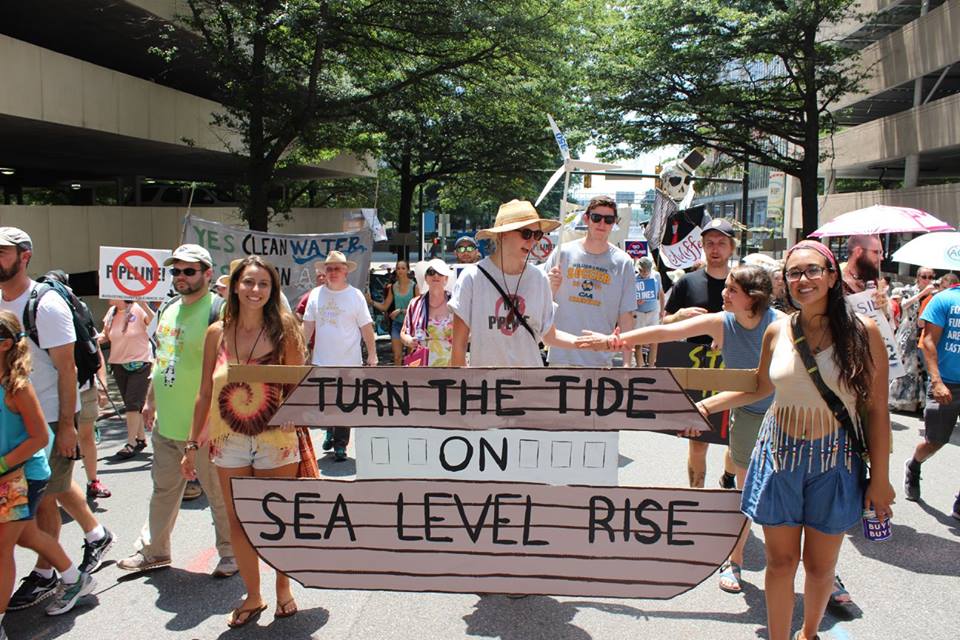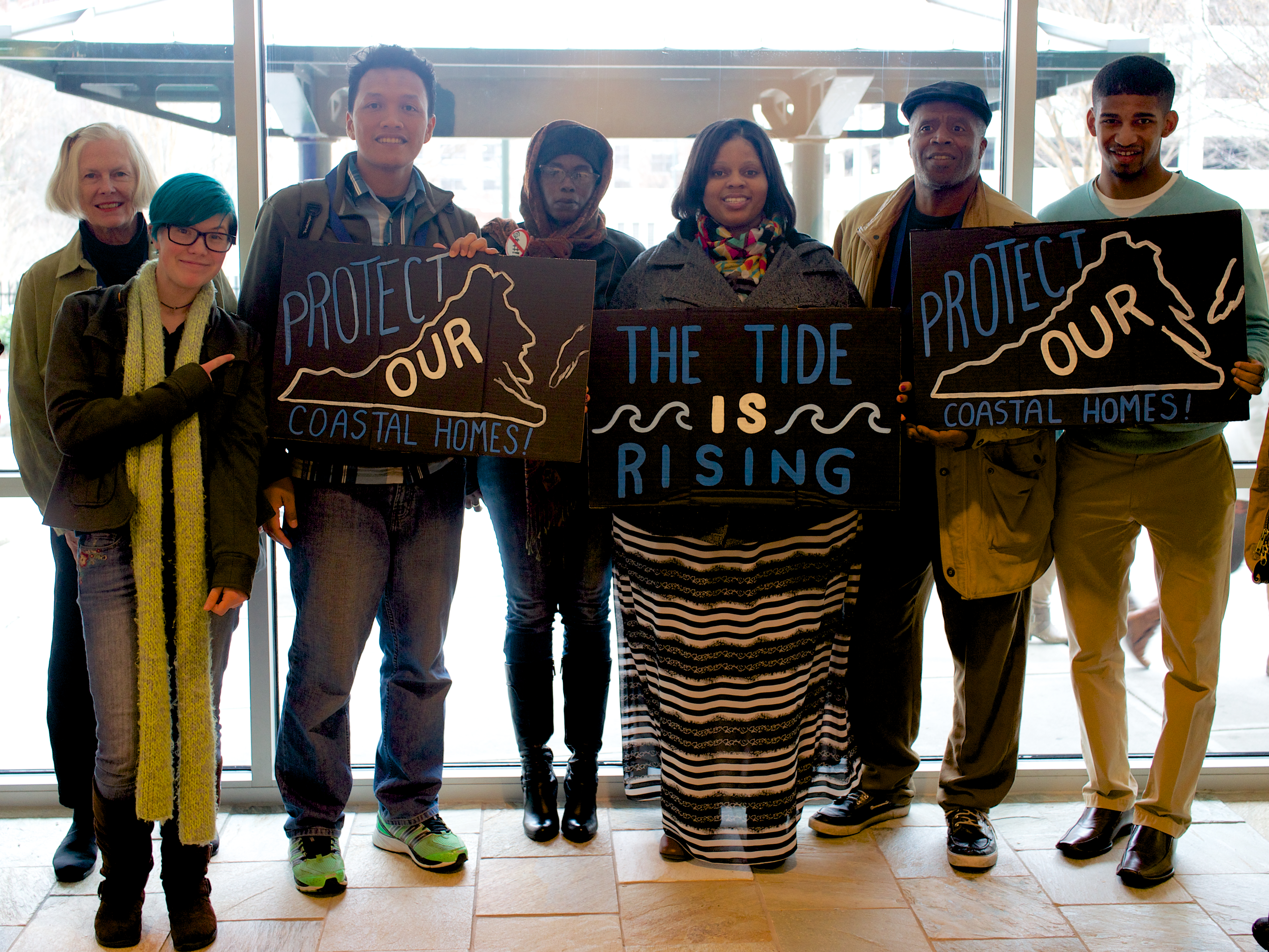I’ve had the pleasure of organizing in Hampton Roads for almost two years now. Climate activists like you have stood beside me as we fought off the threat of offshore drilling on our coast. We’ve come together to tell our personal accounts of living on the front lines of sea level rise through Flood of Voices. We even bothered our local paper, The Virginian-Pilot, so much that they dedicated a section of their website to sea level rise. However, there is another threat that calls us to action yet again: Fracked-gas pipelines.
Virginia’s polluters are moving forward with their plans to construct the Atlantic Coast Pipeline (ACP) and the Mountain Valley Pipeline (MVP) even though they would be locking our coastline into catastrophic climate repercussions. This egregious disregard for public health and lack of foresight has sparked a fire under activists in the Shenandoah Valley and Southwest Virginia. They have shown up to public meetings in droves and they are tirelessly fighting the construction of these fracked-gas freeways.
But they can’t do it alone.
We on the coast have a special obligation to join the fight against these pipelines (and we already are taking action). Throughout the spring and summer, activists in Hampton Roads held meetings with ten legislators urging them to weigh in for a full and fair federal review of both the ACP and the MVP. The long-term effects of an influx of fracked gas into our state will be felt first in Norfolk and the rest of Hampton roads through rising sea levels and more coastal flooding. The immediate impacts will touch us, too. In the Deep Creek community in Chesapeake, landowners and low-income residents face the prospect of the ACP coming into their backyards. Plus, we know what can happen when coastal residents come together to say NO to a fossil fuel project (remember that offshore drilling proposal?).
Across the Commonwealth, there is one more unifying reason why we should be fighting these ludicrous pipelines: water. We all need it, and we all prefer it to be clean. So why would we risk the safety of what pours out of our faucets when we can produce energy from clean sources like offshore wind instead? These pipelines present a very real threat to the thousands of streams, rivers, waterways, and wetlands that have a direct impact on Virginians’ drinking water and to our efforts to remediate the Chesapeake Bay.
The statewide resistance has already begun: over 600 climate activists marched on the Governor McAuliffe’s mansion with a unified message that called for clean energy instead of fossil fuel infrastructure. Just a couple weeks ago, activists across the state (and the country) came together for an event called Hands Across Our Land where they joined hands to loudly proclaim their opposition to pipelines anywhere and everywhere!
 Now, as the Federal Environmental Regulatory Commission prepares an Environmental Impact Study for each pipeline, the resistance must intensify. We expect FERC to release its environmental review of the Mountain Valley Pipeline any day now. But this decision isn’t a federal one alone. Governor McAuliffe has the power to direct his Department of Environmental Quality to deny the Clean Water Act permits for both pipelines and we need to make it VERY clear that it would be in the best interest of the people and our climate that he does just that. Because we know that he sometimes struggles with science of climate change (Just do a quick search of #TeachTerry).
Now, as the Federal Environmental Regulatory Commission prepares an Environmental Impact Study for each pipeline, the resistance must intensify. We expect FERC to release its environmental review of the Mountain Valley Pipeline any day now. But this decision isn’t a federal one alone. Governor McAuliffe has the power to direct his Department of Environmental Quality to deny the Clean Water Act permits for both pipelines and we need to make it VERY clear that it would be in the best interest of the people and our climate that he does just that. Because we know that he sometimes struggles with science of climate change (Just do a quick search of #TeachTerry).
The time is now to join us in fighting off yet another attack on our climate in Virginia. Contact me at harrison@chesapeakeclimate.org and I’ll plug you into one of our community action teams near your city: there, you will gain the tools that you’ll need to be the changemaker Virginia’s climate movement has been waiting for! I can’t wait to celebrate another victory with you.
Coastal Residents Bring the Fight Against Sea Level Rise to Richmond
The residents of Virginia’s Hampton Roads and Tidewater areas are well aware of the dangers that climate change and sea level rise present to them and their communities. Not because they see it on TV or read about it in their local newspaper, but because they are living with the constant fear that their neighborhood could be underwater tomorrow.
A Norfolk resident and passionate CCAN volunteer, Bob Baxter, shared his fears with me just last week: “Twice in two years, I’ve had to help my neighbor clean out a flooded home… If the water rises seven more feet, as scientists say could happen in coming decades, then my house will be in danger as well. Something has to be done.”
Hampton Roads is the most populous region in the Commonwealth and home to the nation’s largest navy base. It’s also second only to New Orleans as the U.S. population center most at risk from rising sea levels. But there is currently no legislation on the books that goes beyond studying the issue of coastal flooding to implementing solutions. That is simply reckless and unacceptable.
On Monday, January 26th, over 40 residents of coastal Virginia (including myself) woke up at 6:00 AM to drive to Richmond and let their representatives know that there is no more time for procrastination: we need to act now! These amazing activists were participants in the Virginia Conservation Network’s (VCN) 2015 Conservation Lobby Day. We came from every major city near the coast to urge our representatives to support the Virginia Coastal Protection Act (HB 2205/SB 1428). This bipartisan bill will raise urgently needed funds for coastal flooding protection measures by joining Virginia into a nine-state regional system for capping carbon emissions.
Even though we were met by dreary weather conditions in the morning, the event was an amazing success. We started the day with very constructive meetings with delegates and state senators from both parties. It was truly powerful to witness so many coastal residents explain to their representatives how coastal flooding is a real problem within their districts at this very moment. Our incredible volunteers were not only voicing their concerns, but also standing up for hundreds of thousands of coastal residents, and I truly believe that the General Assembly was forced to recognize that on Monday.
If the day had ended there, then I could already call it a success. But we still had more work to do in Richmond! After a whirlwind morning full of lobbying in the General Assembly office buildings, a few coastal residents joined Mike Tidwell (CCAN’s Executive Director) and I for a meeting with Virginia’s Chief Resilience Officer, Brian Moran, and a couple other members of Governor Terry McAuliffe’s administration.
This meeting allowed some of our most active volunteers a chance to share their stories with a representative of the executive branch. Mike also laid out the benefits of the policy for them and we had a positive discussion on the next steps. It was an added bonus that Secretary Moran is the Co-Chair of the Governor’s Climate Change and Resiliency Update Commission, so he understood the importance of taking immediate and swift action against climate change. So, by shortly after lunchtime, we had lobbied multiple coastal General Assembly members and an important member of the Governor’s administration: I’d say that’s well worth a couple hours on I-64!
The Conservation Lobby Day was a very important step in the movement towards commonsense legislation that will enable Virginia to meet the coming EPA Clean Power standards and provide substantial revenue for coastal flooding adaptation. However, we are still in the middle of a sprint towards the end of the General Assembly session and the passage of the Virginia Coastal Protection Act.
If you really want to see our legislators take this problem seriously, call your state delegate and let him or her know how important the Coastal Protection Act (HB 2205/SB 1428) is!
After that, it’s time to take the next step: e-mail me at harrison@chesapeakeclimate.org to find out how you can get more involved. After all, our future depends on it.
Coastal Residents Learn About Real Time Climate Solutions at Town Hall Meeting
The impacts of climate change are already apparent in Hampton Roads. The state’s vulnerable coastline continually floods communities, impacting the lives of hundreds of thousands of people throughout the region. Coastal residents are eager to learn and act on solutions to protect the communities they love from the rising tides. On Tuesday, December 2, nearly sixty people came out to CCAN’s “Save Our Coast” town hall and book event to do just this.
Folks who attended the event first heard from Stephen Nash, author of Virginia Climate Fever. Nash spoke about the impacts of climate change on Virginia’s communities and the drastic need for clean energy solutions throughout the state. He warned that the average temperature in the state is on the rise, and Virginia could see double the amount of about 90ºF days by 2065. The first ten months of 2014 have been the hottest on record, since temperature monitoring began around 130 years ago.
Hampton Roads has it much worse though. The region stands as the most vulnerable climate impact zone in Virginia and could see triple the amount of 90ºF days by 2065 – a threat to their beloved ecosystems and public health alike. Even more frightening is the fact that the rate of sea level rise is accelerating along the state’s coast, and it’s already at the doorsteps of thousands of residents. Much of the development in Hampton Roads rests on subsiding land, putting the region at risk for higher rates of sea level rise than will be seen elsewhere along the Atlantic Coast.
This scale of climate disruption does not have to become a reality though, as Virginians can still take action to curtail its greenhouse gas emissions. Nash explained that Virginia can still make the switch to renewable energy at a fast pace to lessen the impacts of climate change on the state. If Virginia acts now to curtail its greenhouse gas emissions, the rate and extent of relative sea level rise will be significantly less than it will be if the state continues to ground its energy consumption on fossil fuels.
One person in the audience asked Nash what the most important thing to be done is. He proceeded to say that taking part in the public conversation is the most important thing for people to do if change is to occur. Mike Tidwell, CCAN’s Executive Director, also answered this question. His response, to which Nash conceded, was for the state to pass the Virginia Coastal Protection Act that would commit the state to the Regional Greenhouse Gas Initiative (RGGI).
Dawone Robinson, CCAN’S Virginia Policy Director, went on to explain the Virginia Coastal Protection Act and RGGI to coastal residents, activists and students alike who gathered for the town hall. RGGI is a cooperative effort between nine states that caps carbon pollution from power plants while requiring them to purchase allowances for every ton of carbon pollution they emit in a given year. By committing to RGGI, the state of Virginia could see over $200 million in revenue by 2020. This revenue would then be appropriated as follows: (1) 50% to Hampton Roads for coastal adaptation efforts; (2) 35% to statewide energy efficiency and clean energy programs; (3) 10% to southwest Virginia for economic development assistance; and (4) 5% to RGGI for programmatic expenses.
Nash and Tidwell both touched on the difficulty of passing bills that support clean energy in Virginia’s legislature. Dominion, the state’s largest energy provider, is highly engrained in the state’s politics, often leaving the statehouse polarized on issues. However, the circumstances for reducing fossil fuel emissions in Virginia have changed radically with the EPA’s Clean Power Plan Rules that will be finalized next summer. The Clean Power Plan is calling on Virginia to reduce its carbon emissions by 38% by 2030, and RGGI stands as the best mechanism for the state to meet its emissions reduction goals while providing funding for essential climate adaptation, mitigation and sustainable development measures across specified regions of the state.
 So what is the most important thing that needs to be accomplished to lessen the impacts of global climate change on Virginians? How can people on the ground help to push for climate solutions that will alleviate the sea level rise impacts that coastal Virginians are facing now, while protecting the future livelihoods of citizens across the state? Each of the featured panelists had a similar position on this question, which was asked by a dedicated activist who attended the town hall and book event. The answer? Get out there and join the public conversation. Talk to your friends, family members, acquaintances, and anyone else you can about bringing climate solutions to the state.
So what is the most important thing that needs to be accomplished to lessen the impacts of global climate change on Virginians? How can people on the ground help to push for climate solutions that will alleviate the sea level rise impacts that coastal Virginians are facing now, while protecting the future livelihoods of citizens across the state? Each of the featured panelists had a similar position on this question, which was asked by a dedicated activist who attended the town hall and book event. The answer? Get out there and join the public conversation. Talk to your friends, family members, acquaintances, and anyone else you can about bringing climate solutions to the state.
Teresa Stanley of Virginia Organizing, the first panelist that the group heard from on Tuesday night, spoke about the importance of collective action to make climate solutions a reality for the state. Communities need to be informed of the risks that Virginia faces under climate change, and communities need to be further mobilized to ensure that the state’s precious neighborhoods, culture and landscapes are protected from the projected devastating impacts.
Quan Williams of Virginia New Majority, the event’s second panelist, said that for her, the most important thing is to get the Virginia Coastal Protection Act passed. Climate change is an issue that know no races, borders, or classes. It will affect us all. And for many of us, climate change is a phenomenon that is capable of presenting itself in life or death situations. We must start acting now, together, to take charge of state initiatives that will turn the tide in the people’s favor.
The last panelist, Dr. Michelle Covi of Old Dominion University, spoke of planning and infrastructure initiatives that need to be updated to best prepare for sea level rise and climate change impacts along the state’s coast, home to the largest naval station in the world. Dramatic storm events are no longer the only driver on flooding in Hampton Roads; heavy downpours and high tides are now of high concern for flooding as well. Municipalities in Hampton Roads need to start working now to improve the resiliency of their highly prized social fabric. Evacuation routes need to be readjusted to include transportation to low-income neighborhoods and houses need to be raised to fight recurrent flooding.
But all of this will come at a cost. Improving infrastructure in Hampton Roads to combat the extensive occurrence of flooding that the region already experiences will need funding to occur, and fast. This is a problem that each and every single municipality in coastal Virginia is facing, and their solution may come sooner than expected. That is if the Virginia Coastal Protection Act passes. In a regular year, CCAN would not dream of getting this bill passed in such a short amount of time. But the fact is that the playing field has changed in Virginia.
The EPA’s Clean Power Plan will be finalized in the summer of 2015, and the state will need to cut 38% of its emissions by 2030. No matter what, the state will need to curb its carbon pollution, and the best option for Virginia is to get ahead of the game and start generating revenue by capping emissions. CCAN has already collected hundreds of petitions to support the Coastal Protection Act and is working to organize communities in support of the bill.
So what’s next? For one, sign the petition to urge your legislators to act if you haven’t already. Also be on the lookout for CCAN’s next actions, which will include a press conference on the bill with the support of coastal elected officials and a coastal lobby day at the state house to push the bill forward. State legislators must understand the immediacy of the threat in Hampton Roads. Together, we can make this happen.



